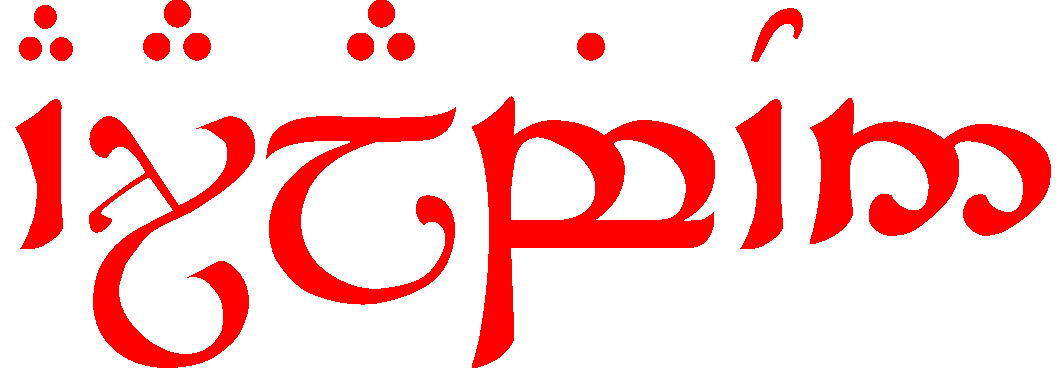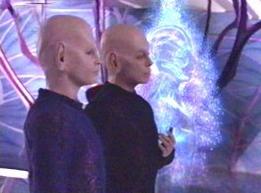
|
OUROBOROS
Languages |
Home to OUROBOROS
Contents
Linguistics
Linguistic Terminology
Word Formation
Classifying Languages
Linguistic Philosophy
Silence
Artificial Languages
thlIngan Hol
Quenya and Sindarin
Eunoia*
Linguistic Terminology
Language can be defined as "communication of thoughts and feelings through a system of arbitrary signals, such as voice sounds, gestures, or written symbols."Linguistics, a field of anthropology, is "the study of the nature, structure, and variation of language." The following are some of the disciplines within linguistics:
- Grammar- The study of how words and their component parts combine to form sentences; the study of structural relationships in language or in a language, sometimes including pronunciation, meaning, and linguistic history; the system of inflections, syntax, and word formation of a language; the system of rules implicit in a language, viewed as a mechanism for generating all sentences possible in that language; a normative or prescriptive set of rules setting forth the current standard of usage for pedagogical or reference purposes; writing or speech judged with regard to such a set of rules; a book containing the morphologic, syntactic, and semantic rules for a specific language.
- Morphology- The study of the structure and form of words in language or a language, including inflection, derivation, and the formation of compounds
- Phonemics- The analysis of how sounds are used to differentiate meaning
- Phonetics- The study of the articulation of sounds in a language and of their distribution in words
- Phonology- The study of the distinctive, contrastive sounds of a language
- Semiotics- The theory and study of signs and symbols, especially as elements of language or other systems of communication, and comprising pragmatics, semantics, and syntactics
- Pragmatics- The study of the relationship between signs, especially words and other elements of language, and their users
- Semantics- The study of meaning in language, including analysis of meanings of words and sentences
- Syntactics- The study of the formal properties of signs and symbols
- Sociolinguistics- The study of language use
- Etymology- The origin and historical development of a linguistic form as shown by determining its basic elements, earliest known use, and changes in form and meaning, tracing its transmission from one language to another, identifying its cognates in other languages, and reconstructing its ancestral form where possible
- Lexicon- a language user's knowledge of words; a reference book containing an alphabetical list of words with information about them
Bonvillain, Nancy. Language, Culture, and Communication: The Meaning of Messages. Upper Saddle River: Premtice Hall, 2000.
Dictionary.com
SOURCE: Bonvillain, Nancy. Language, Culture, and Communication: The Meaning of Messages. Upper Saddle River: Premtice Hall, 2000.
![]()
Word Formation
Languages are not simply collections of words. They are used to convey new ideas. This is one of the tenants of human language. If a tongue cannot express something that has never been expressed before, than it serves little purpose for those with innovative ideas. To express new ideas, a language must be capable of rearranging pre-existent parts to form new words and sentences. There are many ways languages do this.
![]()
Classifying Languages
To better study languages, linguists place them in categories, called families. Every language in the world is related to all others by virtue of human invention. However, some languages have more in common with certain languages than with others. Some of the major language families include: Indo-European, Sino-Tibetan, Malayo-Polynesian, Semito-Hamitic, Niger-Congo, and Dravidian. Each family is divided into subfamilies; the Indo-European subfamilies include Indo-Iranian, Romance, Germanic, and Balto-Slavic. Further, the Romance subfamily can be broken down into individual languages such as French. Within French, there are several dialects, changes in the way the language is spoken in different geographic areas.
All languages within a family share a common ancestry. In fact, there are two different views about the ultimate origin of language: either all languages branched out from one proto-language, or each family emerged from a separate proto-language. Since the invention of spoken language preceded the invention of writing, it is very difficult to find any evidence either way. Each family shares characteristics, such as the system of word formation discussed above. They may also share a remarkable similarity of sound. For instance, the word for mother is similar in many Indo-European languages: Sanskrit maataa, French mere, Italian madre, German mutter, etc...
![]()
Linguistic Philosophy
In the early 20th Century, philosopher Ludwig Wittgenstein theorized that the only question left to philosophy was that of understanding the limits of language. Wittgenstein’s first attempt at understanding language, called “early Wittgenstein”, used painting as a metaphor. A landscape and a painting of a landscape are two different things, yet we can easily identify the painting with the landscape. Wittgenstein believed this was because the logical forms of the two things were the same; in another words we perceived them as being the same. However, Wittgenstein abandoned this approach for one known as “later Wittgenstein” in which he called language a tool. Like a tool, a word has no purpose until it is put to use. Words have no intrinsic meaning, and therefor “the meaning of a word is its use in language.” For instance, the word evidence means something different to a lawyer, historian, and physicist, proving that the meaning comes from the user of the word. Later philosophers used these ideas to support their belief that modern philosophy should be concerned with the unraveling of truths, references, and meanings obscured by our improper and confusing use of language. To these philosophers, most philosophic problems arose from the inaccuracies of language. Since then, modern philosophy has been mainly concerned with questions of logic and linguistics.
![]()
Silence
What is the meaning of silence? Though many would define it as the "absesne of speech," silence communicates as effectively as any words, through body language, facial expression, and proximity. Silence carries different connotations in different cultures. Some view silence as a sign of respect; others view it as the proper behavior between strangers; still others believe silence is a part of rituals, including the grieving process. Americans tend to think of silence as ominous. They associate feelings of "hostility, disdain, disinterest, and anger" with persons who do not speak. Many American language rituals like "formulaic greetings, so-called 'small talk,' and frequent question and answer sequences" as ways to "avoid silence." However, the silent person may simply be showing peacefulness and respect for others or expressing his or her contemplative nature.
thlIngan Hol
 thlIngan Hol, the official language of the Klingon Empire on Star Trek is a harsh language composed of short, clipped sounds and guttural, "growls." The language reflects the cultural norms of Klingon society--aggression, directness, and confidence. Klingon grammar is characterized by the use of prefixes and suffixes to add vowel tenses and prepositional relationships to words. Basic Klingon is simple, but complex sentences are multifaceted and carry a great deal of meaning. thlIngan Hol has been developed over many years by many people. The Klingon sound was first created by actor James Doohan who played Scotty on Star Trek and later fleshed out by linguist Mark Okrand. Several other Klingon languages, including klingonaase, have been developed by fans. There are many resources for those interested in learning thlIngan Hol including The Klingon Dictionary, The Klingon Way, The Klingon Galactic Traveler by Mark Okrand, and the audiocassettes Power Klingon and Conversational Klingon.
thlIngan Hol, the official language of the Klingon Empire on Star Trek is a harsh language composed of short, clipped sounds and guttural, "growls." The language reflects the cultural norms of Klingon society--aggression, directness, and confidence. Klingon grammar is characterized by the use of prefixes and suffixes to add vowel tenses and prepositional relationships to words. Basic Klingon is simple, but complex sentences are multifaceted and carry a great deal of meaning. thlIngan Hol has been developed over many years by many people. The Klingon sound was first created by actor James Doohan who played Scotty on Star Trek and later fleshed out by linguist Mark Okrand. Several other Klingon languages, including klingonaase, have been developed by fans. There are many resources for those interested in learning thlIngan Hol including The Klingon Dictionary, The Klingon Way, The Klingon Galactic Traveler by Mark Okrand, and the audiocassettes Power Klingon and Conversational Klingon.
![]()
Quenya and Sindarin
 These Elven languages developed by J. R. R. Tolkien may have perhaps the largest vocabulary of any artificial language. The sound and structure of Quenya is based upon Finnish, and Sindarin is based upon Welsh. Old English and other tongues of the British Isles also had an influence on Tolkien's work. The Elven tongues were designed to be perfect for song or poetry, the most elegant forms of expression to the Elven mind. The grammar of these languages is similar to Latin and is just as complex. Tolkien was quoted as saying that he wrote his famous Middle-earth books simply to create a world in which his invented languages, the works he spent most of his life developing, could be spoken. Besides Quenya and Sindarin, more than ten other languages were created for Middle-earth.
These Elven languages developed by J. R. R. Tolkien may have perhaps the largest vocabulary of any artificial language. The sound and structure of Quenya is based upon Finnish, and Sindarin is based upon Welsh. Old English and other tongues of the British Isles also had an influence on Tolkien's work. The Elven tongues were designed to be perfect for song or poetry, the most elegant forms of expression to the Elven mind. The grammar of these languages is similar to Latin and is just as complex. Tolkien was quoted as saying that he wrote his famous Middle-earth books simply to create a world in which his invented languages, the works he spent most of his life developing, could be spoken. Besides Quenya and Sindarin, more than ten other languages were created for Middle-earth.
The Languages of Tolkein's Middle-earth by Ruth Noel is a beginner's guide to Tolkein's linguistic creations.
Here are some Elven phrases in Quenya...
![]()
Eunoia
 The mysterious and almost whispered language Eunoia, which is an obscure English word meaning "beautiful thinking", is the language of the Taelons, or Companions, on Gene Roddenberry's Earth: Final Conflict. Eunoia, characterized by aspirated vowels and clipped, purring consonants, is a language of dual meanings. Depending on how a word is pronounced, it can be a greeting or a veiled threat, reflecting the alien Taelon philosophy. Because the Taelons are genderless and think as a group, their language doesn't include words for "he" and "she" and uses the plural forms of words as their standard form. Eunoia also doesn't reflect tense, as in past, present, or future, because the Taelons do not consider moments in time to be separate. Eunoia is written in three dimensions and reading it is a matter not only of translation, but also of emotional insight and empathy.
The mysterious and almost whispered language Eunoia, which is an obscure English word meaning "beautiful thinking", is the language of the Taelons, or Companions, on Gene Roddenberry's Earth: Final Conflict. Eunoia, characterized by aspirated vowels and clipped, purring consonants, is a language of dual meanings. Depending on how a word is pronounced, it can be a greeting or a veiled threat, reflecting the alien Taelon philosophy. Because the Taelons are genderless and think as a group, their language doesn't include words for "he" and "she" and uses the plural forms of words as their standard form. Eunoia also doesn't reflect tense, as in past, present, or future, because the Taelons do not consider moments in time to be separate. Eunoia is written in three dimensions and reading it is a matter not only of translation, but also of emotional insight and empathy.